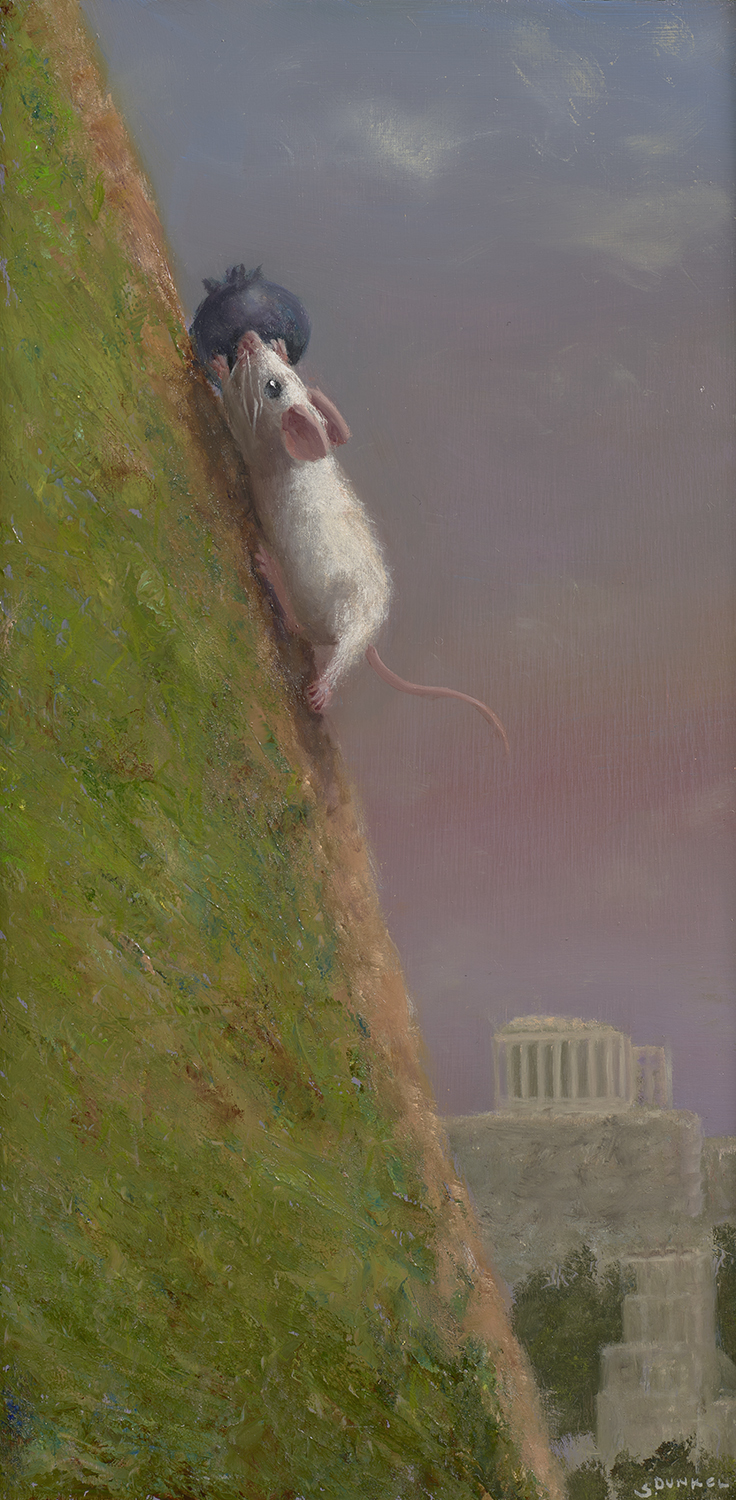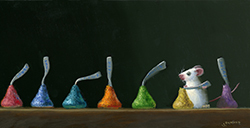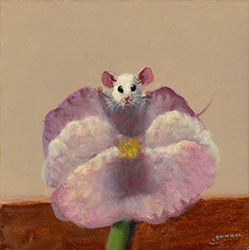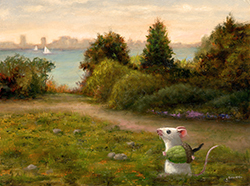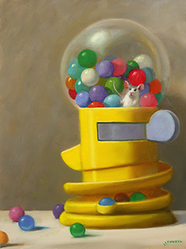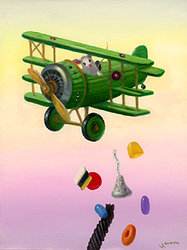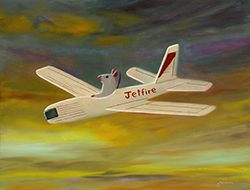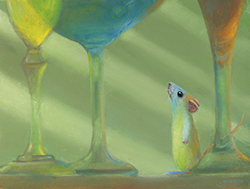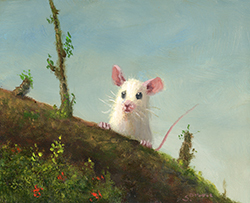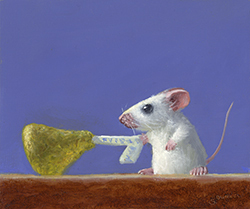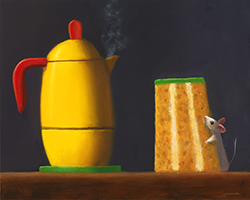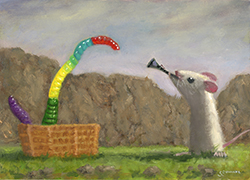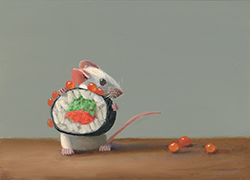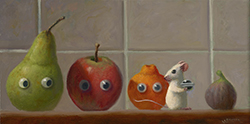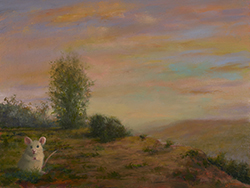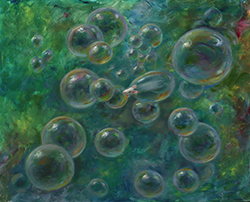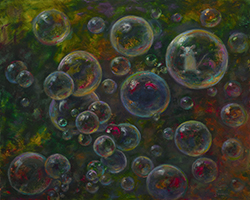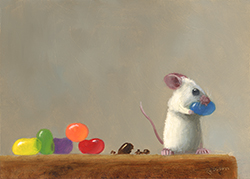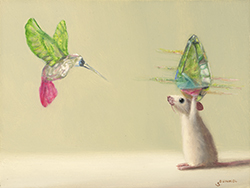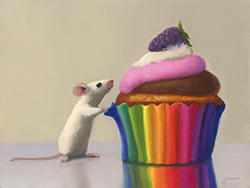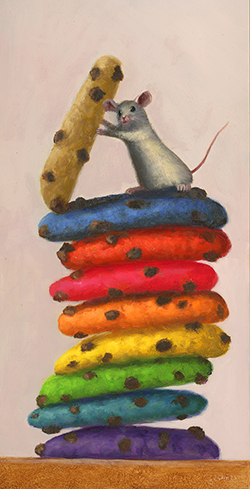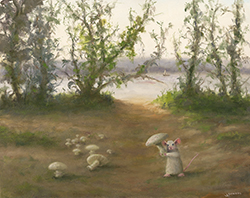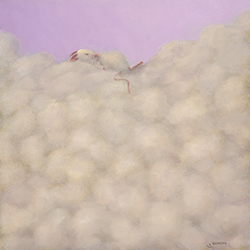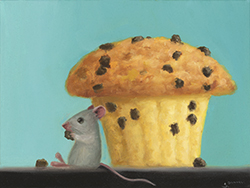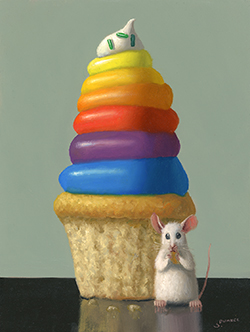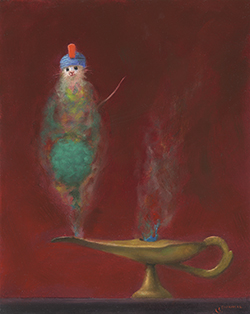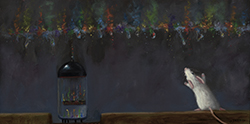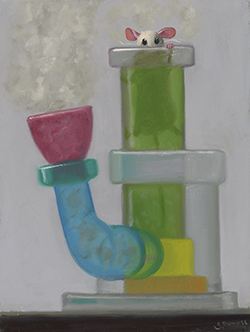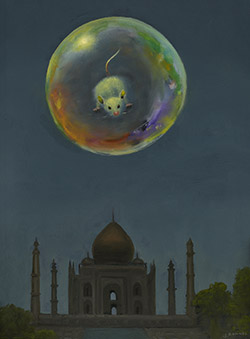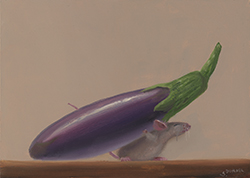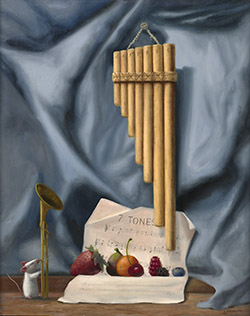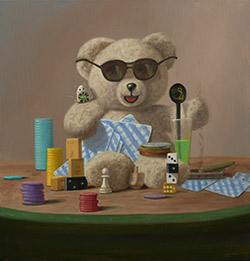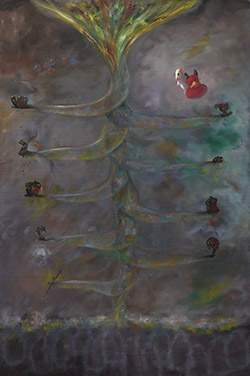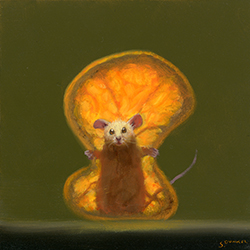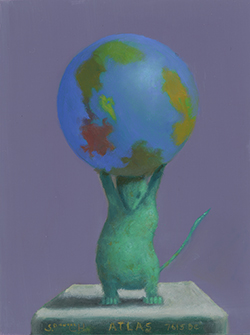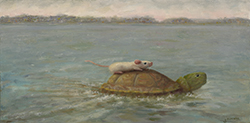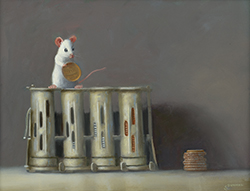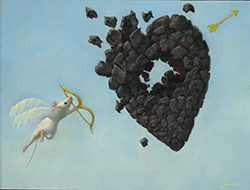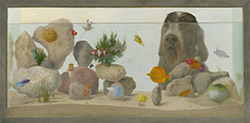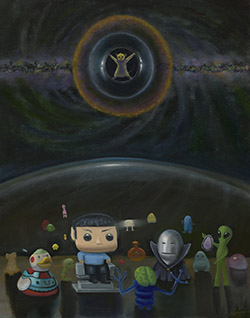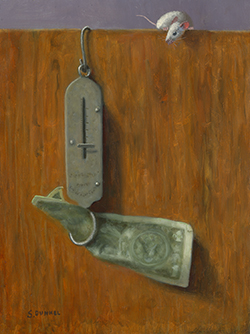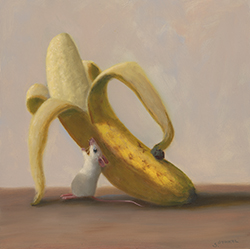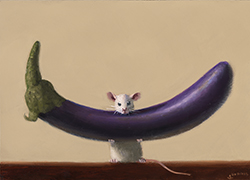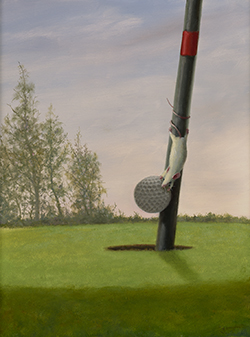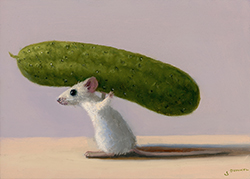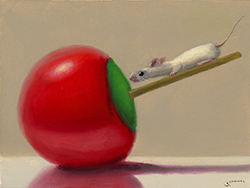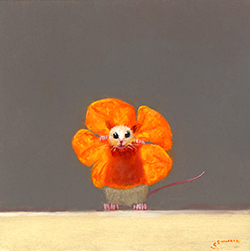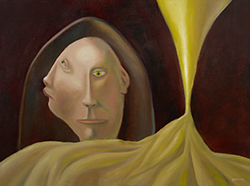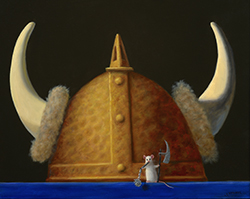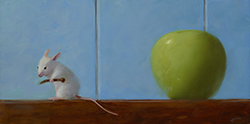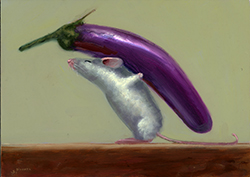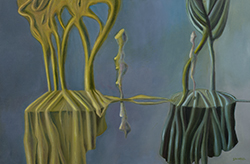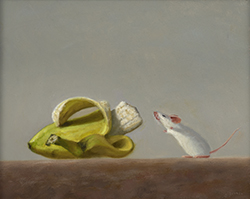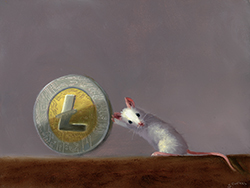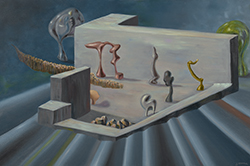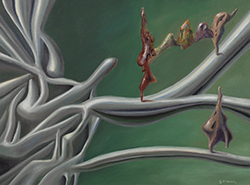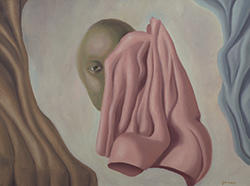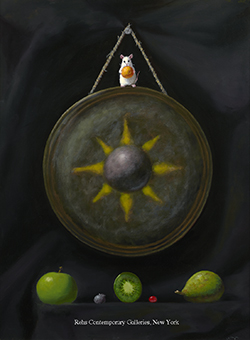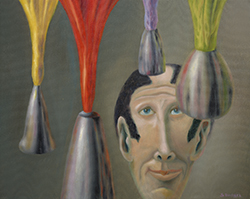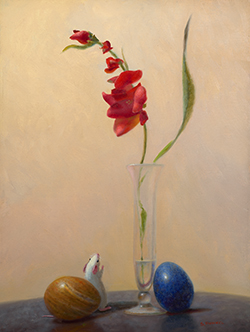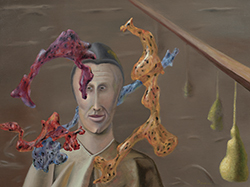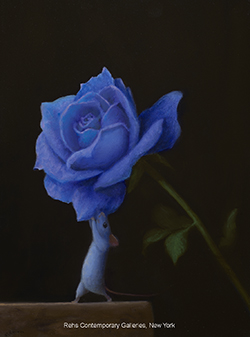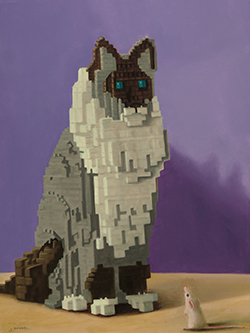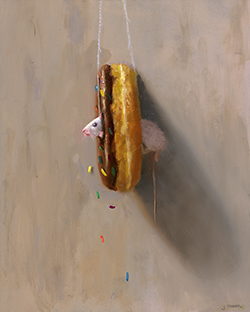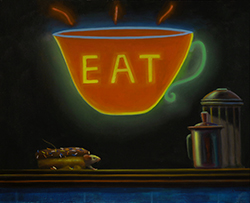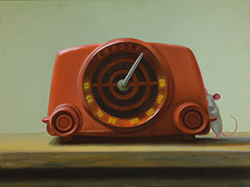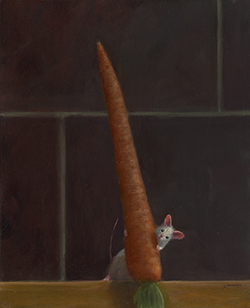Stuart Dunkel
(Born 1952)
Sisyphus
Oil on panel
12 x 6 inches
Signed
BIOGRAPHY - Stuart Dunkel (Born 1952)
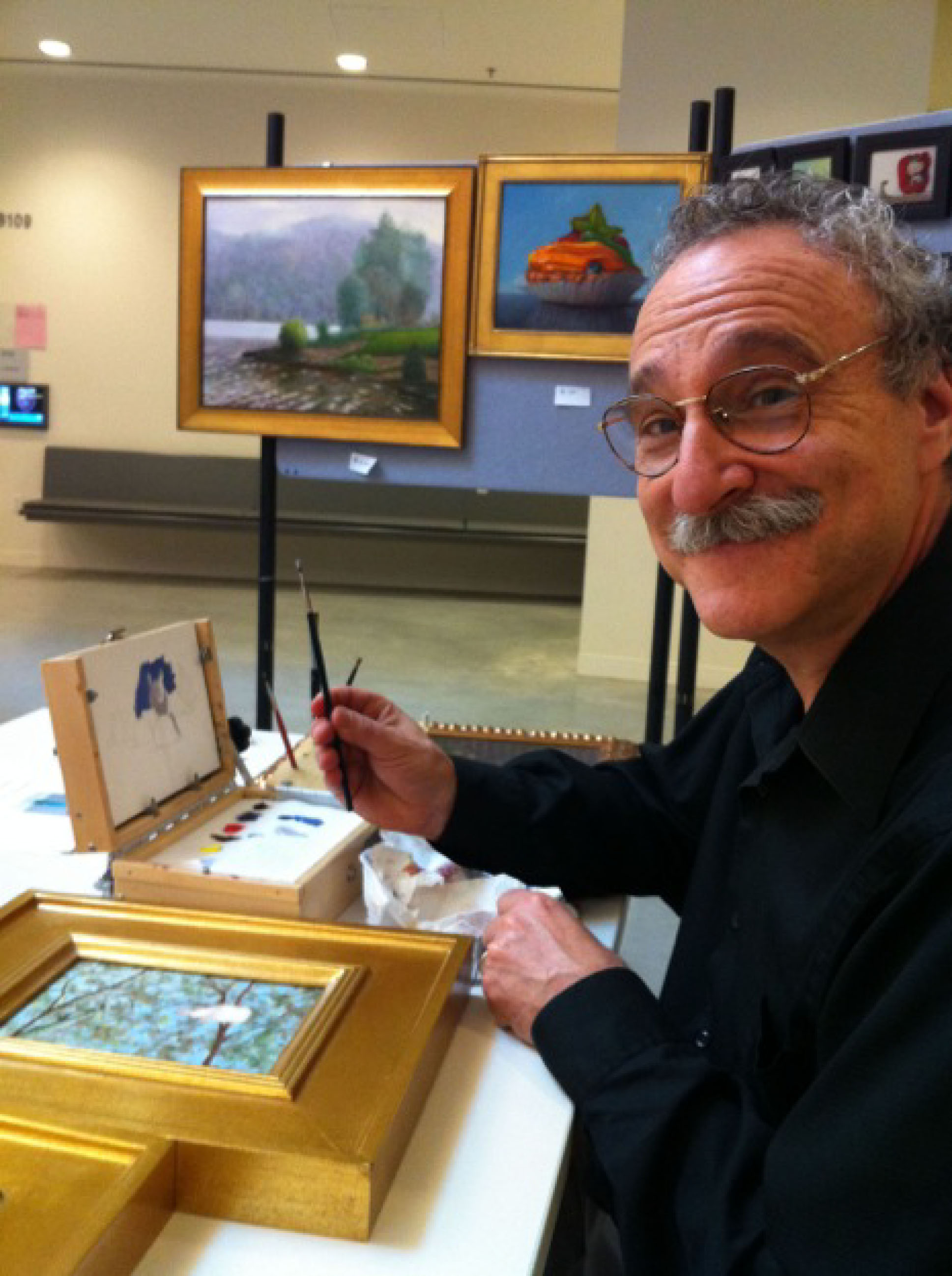
Painter and musician Stuart Dunkel grew up in Fairlawn, New Jersey, the youngest son of two psychologists. His interest in art emerged in early childhood, but an art education class that his mother enrolled him in at age five proved to be a “horrible experience”. In the short term, that was the end of the young Dunkel’s interest in art. His attention turned to music, specifically to the clarinet which ultimately led him to a successful career as a classical musician.
Throughout his school years, Dunkel focused almost exclusively on music, and by the time he reached high school, his teacher and mentor designed a unique musical curriculum tailored to his development as a musician. By that time, Dunkel had shifted from the clarinet to the oboe. After graduation, he received a scholarship to Boston University where he soon realized that his high school teacher had given him a far more thorough foundation in music and music history than most of his classmates.
Dunkel’s years at Boston University proved to be an important springboard for his career. One of the coaches for the music program worked in human resources for the Boston Symphony Orchestra; and when there was a need for a substitute oboist at the Symphony, he asked Dunkel to step in. For a young musician, this was a rare opportunity, both to learn from experienced musicians and to develop a fuller understanding about participating in an internationally acclaimed symphony orchestra.
Following his college graduation in 1975, Dunkel was immediately hired as the full-time oboist for the Boston Opera Company, and he also continued working as a contractor for the Symphony. Unfortunately, the Opera Company’s financial stability diminished over the course of the 1970s and early 1980s, leading Dunkel to leave Boston to pursue his career elsewhere. In the opening years of the 1980s, he worked as the solo oboe for the Hong Kong Philharmonic and the Florida Gulf Coast Symphony. Subsequently, he moved to New York to attend the Mannes College of Music where he received a masters degree in 1985, and then went on to complete a doctoral program at Juilliard School of Music in 1987.
With his newly minted doctoral degree in hand, Dunkel returned to Boston as a faculty member at both Boston University and the Boston Conservatory. This was a productive period; he started a small company to produce reeds for the oboe and he wrote his first book, The Audition Process: Anxiety Management and Coping Strategies. Perhaps most significantly, he met and married his wife Mary in 1992.
Throughout these years, Dunkel had been painting in his spare time, but it was not until 1994 that he began to move away from music as his primary career and into the visual arts. This was prompted in part by a weariness with the often insular culture of academia and in part by a curiosity about other possibilities; in addition, Dunkel’s reed business provided a regular income.
One of Dunkel’s first decisions as a visual artist was to begin classes at the School of the Museum of Fine Arts. It was there that he studied basic composition and technique with an emphasis on classical painting traditions. A few years later he studied with Scott Fraser at the Academy of Realist Art in Seattle. On his return to Boston, he began to build his career as a painter, continuing to take workshops with a variety of well respected artists.
Dunkel recalls that he began by painting images of dogs. As he remarks, “I enjoyed painting them, but they didn’t sell.” Recognizing the need to explore a wider range of subjects, he began including other animals, one of which would become his most characteristic creation, the small mouse. The mouse paintings first appeared as part of a running joke with his wife about why there were crumbs on the kitchen counter. Dunkel included one of them in an exhibition at the Lyman-Eyer Gallery in Provincetown, Massachusetts, not really expecting that it would sell. As he was packing up his work at the end of the show, however, a client saw the mouse painting sitting on the floor and purchased it immediately.
Since then, the mouse has become Dunkel’s most familiar image. He describes these paintings as “a magnificent obsession” and notes that the process is similar to playing music, always bringing a fresh interpretation to the performance. The mouse is clearly autobiographical, but he is also a universal spirit, sharing emotional experiences that range from delight to fear—usually with a sense of humor as well.
Like many series painters, from Claude Monet to Andy Warhol, Dunkel is fascinated with abstract and formal harmonies in his compositions as well as the immediate subject. Viewed from a distance, the specific elements of the mouse paintings transform themselves into explorations of color and shape and line, creating patterns and revealing structures that are not apparent at first glance.
In the first decade of the twenty-first century, Dunkel concentrated on continuing education and on assimilating the culture of the classical realist art world. He entered juried competitions, receiving a prize in 2004 at the Westford Art Show in Westford, Massachusetts. The following year, his work was accepted at the prestigious Salmagundi Club’s Realist Competition in New York. In 2006, he served as a guest lecturer on the topic of “Art and Anxiety” at Wellesley College; and returned for an encore in 2007.
The next two years solidified Dunkel’s reputation as a serious artist in the Boston art world. He was a Silver Medal winner at New England Representational Competition sponsored by The Guild of Boston Artists in October of 2007; and the recipient of the Crisp Award for Best of Show at the exhibition organized by the Copley Society of Boston in November. In the summer of 2008, he again received kudos from the Copley Society of Boston at the Members Summer Show Competition where he won first prize.
In the summer of 2008, Dunkel also teamed up with a friend to produce what was intended to be a marketing pamphlet on his ideas about art. The project grew far beyond the original idea however, and eventually became Dunkel’s second book. Published in 2009, An Artist’s Life: Insights into the Paintings of Stuart Dunkel offers the painter’s insights into the process of painting from three perspectives: technical, creative, and spiritual.
During this period, Dunkel also continued to seek out teachers within the classical realist tradition; one of the most influential was Joel Carson Jones, himself a student of Anthony Waichulis of the Ani Art Academies. Dunkel traveled to northeastern Pennsylvania to work with Jones and was pleased to be invited to participate in the Anthony Waichulis Invitational in 2011. That year’s exhibition, titled Capturing Realism, was held at the Pauly Friedman Gallery at Misericordia University in Dallas, Pennsylvania. This was an opportunity to meet other artists working in the realist tradition, as well as a chance to show his paintings to the art dealers who attend the annual show.
Back home in Massachusetts, Dunkel continued to take classes with respected local painters, and in 2010, he agreed to teach a basic class after his own teacher moved to New York. Today, he is the director of the Nautilus School of Realist Art in Watertown, Massachusetts where he continues to teach a small coterie of students. As always, the discipline that he mastered as a young musician serves him equally well as a painter. His work has grown in depth and meaning over the years, and when asked about his goals for the future, he replies simply that he “hopes to keep improving.”
Janet Whitmore, Ph.D.
| AVAILABLE WORKS | ||||||||||||||||||||||||||||||||||||||||||||||||||||||||||||||||||||||||||||||||||

